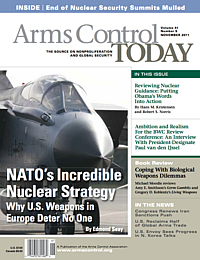New Article On Obama Administration Nuclear Targeting Review
 |
| New article published in Arms Control Today |
.
By Hans M. Kristensen
The latest issue of Arms Control Today includes a new article by Robert Norris and myself about the nuclear targeting review that is currently underway in the Obama administration.
In ordering the review, formally known as the Post-NPR Review, President Obama has asked the military to review and revise U.S. nuclear strategy and guidance on the roles and missions of nuclear weapons, including potential changes in targeting requirements and alert postures, in preparation for the next round of nuclear reductions beyond the New START treaty with Russia.
Our article describes the bureaucratic labyrinth the review will go through before new presidential guidance emerges to change the U.S. nuclear war plan. To that end, we offer a wide range of suggestions for how the review could reduce the requirements for U.S. nuclear forces to “put an end to Cold War thinking,” as President Obama said in his Prague speech in 2009.
Note: accessing the article requires subscription to Arms Control Today.
Further information: Obama and the Nuclear War Plan (FAS, 2010).
This publication was made possible by a grant from Carnegie Corporation of New York and Ploughshares Fund. The statements made and views expressed are solely the responsibility of the author.
While advanced Chinese language proficiency and cultural familiarity remain irreplaceable skills, they are neither necessary nor sufficient for successful open-source analysis on China’s nuclear forces.
Satellite imagery has long served as a tool for observing on-the-ground activity worldwide, and offers especially valuable insights into the operation, development, and physical features related to nuclear technology.
This report outlines a framework relying on “Cooperative Technical Means” for effective arms control verification based on remote sensing, avoiding on-site inspections but maintaining a level of transparency that allows for immediate detection of changes in nuclear posture or a significant build-up above agreed limits.
The grant comes from the Carnegie Corporation of New York (CCNY) to investigate, alongside The British American Security Information Council (BASIC), the associated impact on nuclear stability.